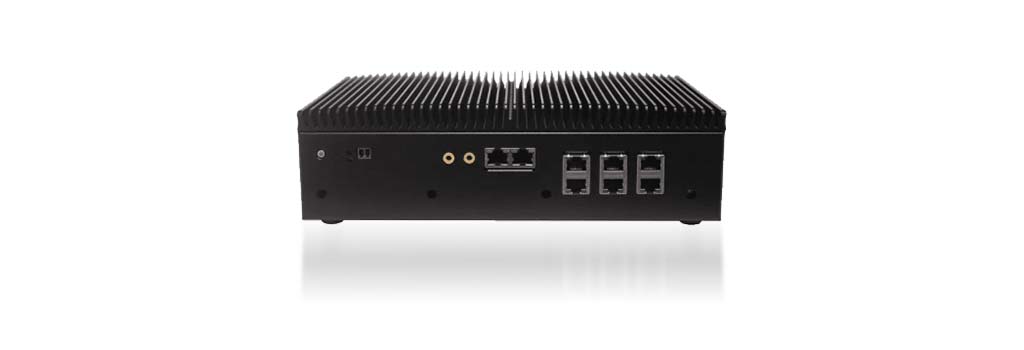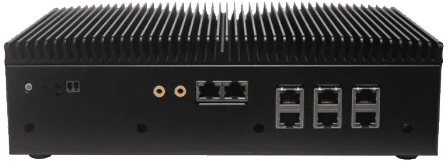Applying AI to Industry 4.0 would introduce opportunities to ignite (or improve) smart factories, automation, predictive maintenance, computer vision, or robotics. But, AI is often found in the cloud, far away from where data is generated and stored. Without ultra-fast broadband technology like 5G or high-end network infrastructure, taking and receiving data for enterprise-level AI is nearly impossible. AI processing needs to happen at the edge, where latencies are low and data privacy high.
An Edge AI-enabled industrial embedded computer or Industry PC (IPC) is a vital piece of hardware for any organization looking towards Industry 4.0 and its benefits. These IPCs are rugged, fanless, and computational devices that, not only should work under demanding industrial environments, but also provide outstanding performance and reliability to meet today’s high application demands.
A good example is the LEC-2680, a Tiger Lake-powered IPC that delivers the right capabilities for edge AI and works under demanding industrial edge conditions.

Intel announced the new Tiger Lake IoT processors at the virtual Intel Industrial Summit 2020. The 11th Gen Intel® Core™ mobile processors are shipped with Iris® Xe graphics “Tiger Lake”. Tiger Lake is the codename for Intel’s 11th generation Intel® Core mobile processors based on the Willow Cove Core microarchitecture.
The processor delivers exceptional performance and responsiveness for time-sensitive applications and AI workloads. The 11th Gen Intel® Core™ i (Up to i7-1185GRE) is industry-focused. The Intel Core GRE—Tiger Lake UP3 is explicitly designed for industrial-grade mini-PCs and embedded computers with passive cooling technology. These processors can operate in wide temperature ranges backed up with fanless technology.
Integrated Graphics
Intel shipped their Tiger Lake UP3 11th generation of (Core i5 and i7) processors along with the Intel® Iris® Xe Graphics (also known as Intel Xe). The integration of graphics is targeted to power mid-range to high-end tiny PCs and thin-design computers to run intensive graphics. It is a great fit for high-graphics gaming, immersive experience, up to 8K video, and enhancing AI.
The LEC-2680.

LEC-2680
✔ Rugged and Fanless Computing Vision IPC.
✔ 11th Gen Intel® Core™ i Series CPU (Codename Tiger Lake-UP3)
✔ Industrial grade PoE network appliance.
LEC-2680 is a rugged and fanless Computing Vision Tiger Lake-powered Industrial Embedded Computer. Aside from having the right processing capabilities, this Industrial PC (IPC) comes with machine vision and video features to enable compute-intensive video-related and edge AI applications.
The processing prowess makes this industrial embedded box PC, the right fit for industrial IoT, retail, healthcare, vision, factory automation, cellular V2X, robotics, edge AI, or almost any Industry 4.0 application.
LEC-2680 Features.
- Processing and Graphics. The Tiger Lake UP3 embedded box PC is powered by the 11th Gen Intel® Core™ i (Up to i7-1185GRE), Codenamed TigerLake-UP3 processor. The processor comes with four cores and a frequency of PBF1.80GHz, MaxTurbo to 4.4GHz. Paired with the new Intel® Iris® Xe Graphics, the platform (LEC-2680) provides an almost 3x faster graphics performance.
- Powerful Memory. All Tiger Lake processor models support DDR4-3200 memory. The LEC 2680 industrial embedded computer comes with two DDR4 2133/2400 SO-DIMM memory cards, with a maximum capacity of 64GB.
- Rich I/O and Network. Lanner’s LEC2680 provides I/O flexibility to support the new IIoT sensors and the legacy systems and devices. It comes with two serial ports (RS232/422/485), eight isolated DI, four isolated DO ports, and four USB3.0 ports. When it comes to network, the LEC2680 provides two 2.5Gbps (RJ45) and six GbE (RJ45 For PoE+) ports. In addition, you can expand the platform to support 4G/5G or WiFi6.
- Purpose-built Rugged and Fanless IPC. Industrial embedded computers must be low-maintenance and highly reliable systems that can work 24/7 without manual intervention in challenging environments. A fanless industrial embedded computer such as LEC-2680 is designed to dissipate energy using fanless technology. LEC-2680 is validated and certified to work under extreme conditions. The internal components of this platform are protected from harsh environmental exposure, including wide temperatures, humidity, vibration, and shock.
Empowering the Industrial Edge Through AI.
So far, the story for AI has revolved around the cloud. Generally, AI workloads, at least at the enterprise scale, would require large amounts of data, and robust, reliable, and non-stop compute-intensive workloads—usually only found in the cloud.
Edge AI decentralizes this power needed for AI and brings it to the edge. It leverages edge computing to introduce ultra-low latencies, offline execution, higher data privacy, and lower costs. Rather than focusing on improving the highway (network infrastructure), edge computing helps empower the technology at the last mile (on-premise or next-hop). This results in analytics and visual solutions that work at the edge for various industries, including manufacturing, retail, healthcare, etc.
The new Tiger Lake-powered industrial embedded computer is an optimal fit for AI applications that need to run at the industrial edge.
Tiger-Lake Powered Embedded Computer Use Cases for Edge AI.
Edge AI computing solutions can accelerate and simplify AI deployments at the industrial edge. Along with Machine Vision (MV) capabilities, Edge AI brings key functions such as object detection, inspection tracking, recognition, or classification. Such functions are vital for making faster and better decisions on embedded computers with edge video analysis. Such AI-based Machine Vision systems would help organizations within different industries, from construction, manufacturing, health, to retail, bring Artificial Intelligence (AI) to their edge.
MV-enabled Edge AI can also introduce factory automation with predictive maintenance alerts and video surveillance for the assembly line. It can also introduce (or enhance) AI applications such as facial recognition or fever detection to improve security at the gates.






